(De)Compressing History
The Great Wall of Los Angeles and the problems of public art.
One hundred years ago, North Hollywood was nothing but ranches. Back then it was known as West Lankershim. Municipally, it was not part of Los Angeles. When the drought came, the struggling ranchers mortgaged their properties to the fruit companies and agreed to be annexed into the city. They were promised water from the LA Aqueduct, but that water never came. It didn’t take long before the ranches were foreclosed and sold off to developers.
That was in the 1920s. The drought is still here of course. And apart from a small, over-developed Arts District, the renamed North Hollywood doesn’t feel very much like Hollywood. It’s blocky, suburban, and has just as strained a relationship with its ecology as ever.
Like many other branches of the LA River, the Tujunga Wash is enclosed by giant concrete slabs. Parts of it are walkable though, with gravel paths and benches placed on either side. You can find a handful of joggers on it each morning: the kinds of people who insist that they live in Valley Village rather than North Hollywood.

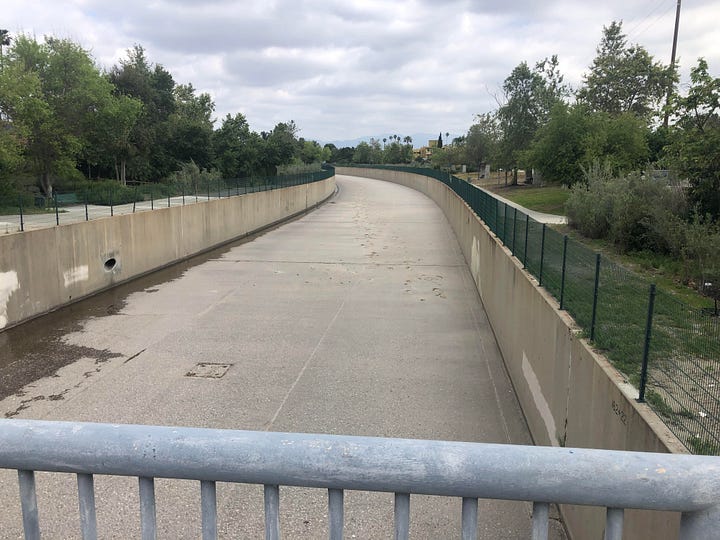
Cross Oxnard, going south. On your left, more nondescript suburban faff. On your right, Los Angeles Valley College, part of the city’s network of community colleges. It is a campus that can mostly be described as pleasant, and you struggle to find any stronger words for it.
Cast your gaze down, in between you and the edge of the campus. It’s the Great Wall of Los Angeles, and it’s a mural on the concrete side of the Tujunga Wash: a strange, somewhat unassuming place for an impressive attempt to capture all the horror and beauty of LA.

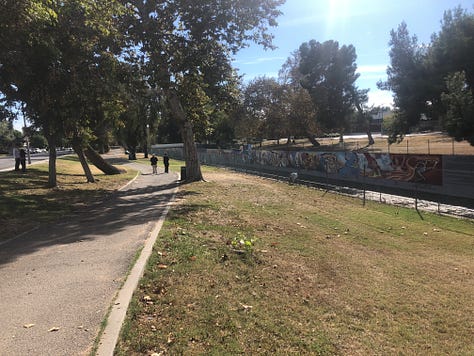
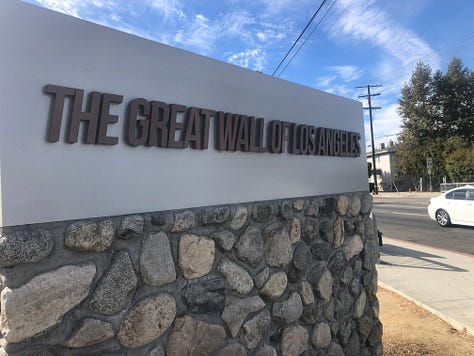
Started in 1978, the Great Wall is technically unfinished. Theoretically, it never will be, at least until this frustrating homunculus of a city finally empties itself into the ocean. It is a chronological history of the mass of land we came to call Los Angeles, starting way back in prehistory, and stopping with the 1984 Olympics. In between, all the things we call history, but from a distinctly, if sometimes uneven, bottom-up perspective.
We might loosely but accurately refer to this mural as a kind of people’s history of Los Angeles; appropriate, considering it origins in the New Left and the Chicano movement. SPARC, the organization that conceived and spearheaded the project, has as its mission “creating sites of public memory.” The mural’s affinities with Diego Rivera, José Clemente Orozco and others are clear, the way it swoops through different events and sews them together, trying to find different levels of grace in the anarchy.
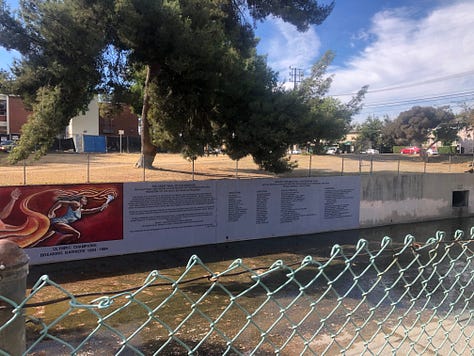
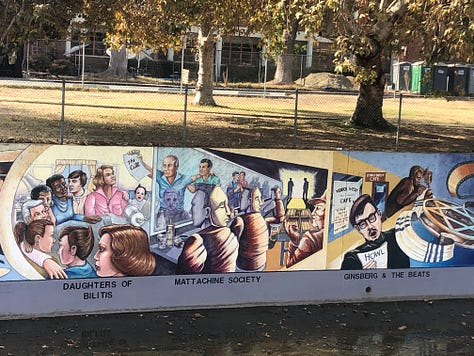

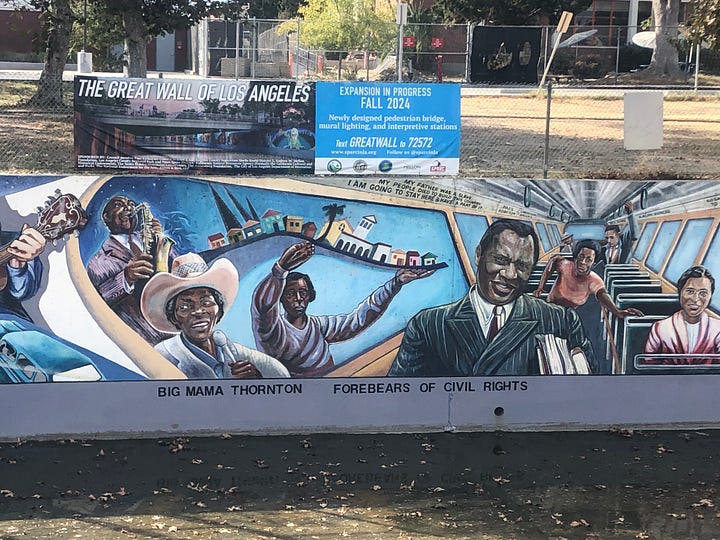
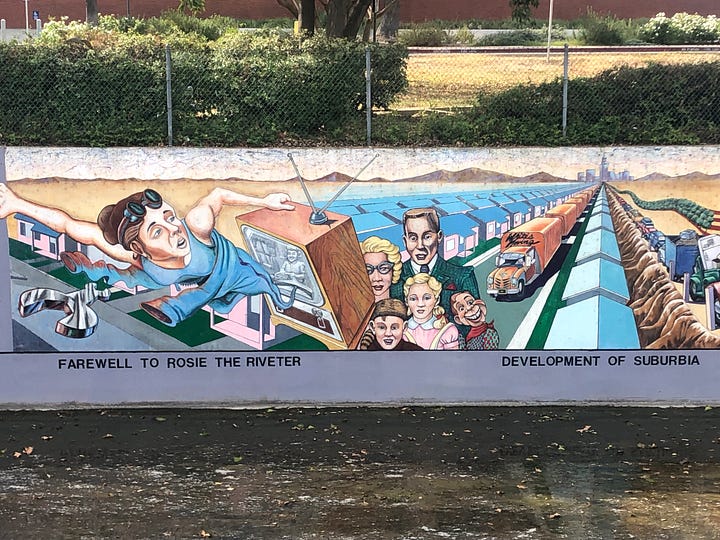
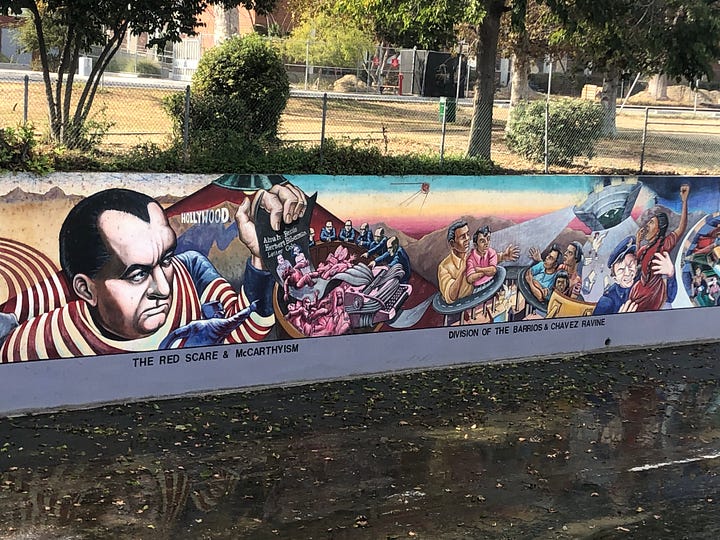

The ideal and predictable route starts at the corner of Burbank and Coldwater Canyon Boulevards, and with the wash on your left side, goes north along the asphalt path. This takes you chronologically through the story of LA. Because of where my apartment is, however, I find myself walking the Great Wall backwards most days. Back through the Mattachine Society and the LA chapter of the Daughters of Bilitis, through the grip of McCarthyism in Hollywood and the exile of Rosie the Riveter back into the home, the internment of Japanese-Americans at Manzanar, fights for equal pay and against segregation, the zoot suit riots, the arrival of dust bowl refugees.
Keep going: the birth of the film industry in what was still a desert town, indentured Chinese migrants building the railroads, the violent transfer of the territory into American hands. Even further: the rise of the Californios and the merciless Catholic missions, the arrival of the Spanish. Further still: back to the height of the Chumash people, and finally to the strange plants and animals that inhabited Southern California before anyone ever dreamt up the idea of history.
There is a contradiction at the center of public art, one we don’t acknowledge or even always know to look for. Its purpose, at least in the abstract, is to open the viewer up to the possibility of the space. If it is a monument or memorial, then we are of course reminded of the past, commonly something that took place there. It isn’t always clear to what end we are to remember, but we can at the very least guarantee that there is some kind of different behavior expected of us.
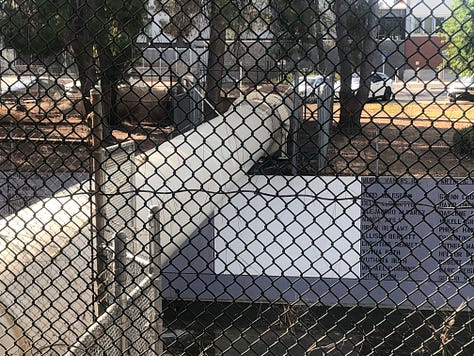


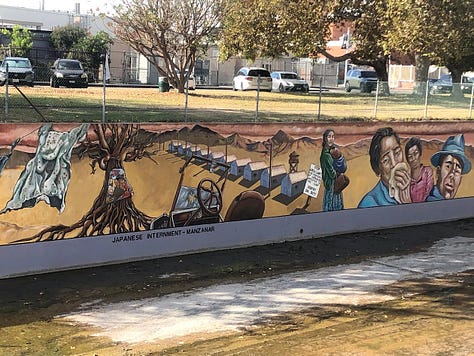
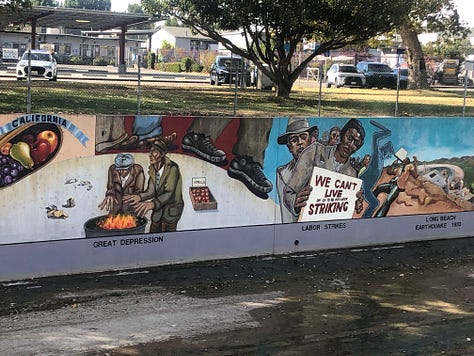



If the art is more capacious in its subject matter, up to and including the abstract, then more often than not it exists with an eye toward the future. Quite often the city planners who assent to the art’s placement are unaware of it, but the invitation to imagine, to provoke, is always there. If we interact with this provocation in the intended way, then the compression of history becomes an unfurling of events.
Think, for example, of the giant Picasso sculpture sitting in Chicago’s Daley Plaza. Most people passing by – normally those who work nearby, normally with a smattering of tourists – don’t stop to consider what this piece of art asks of us. Put a gaggle of small kids nearby though, and you’ll see them start to climb up and down, under the weird face that looks out across the square. A spatial gap in bureaucracy and commerce is turned into a playground.

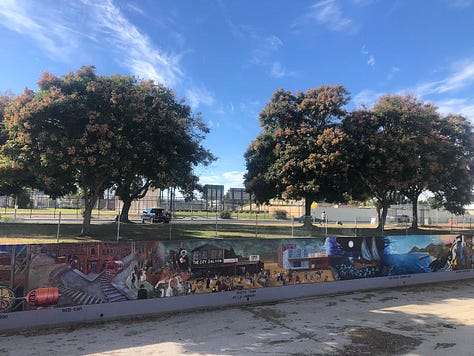

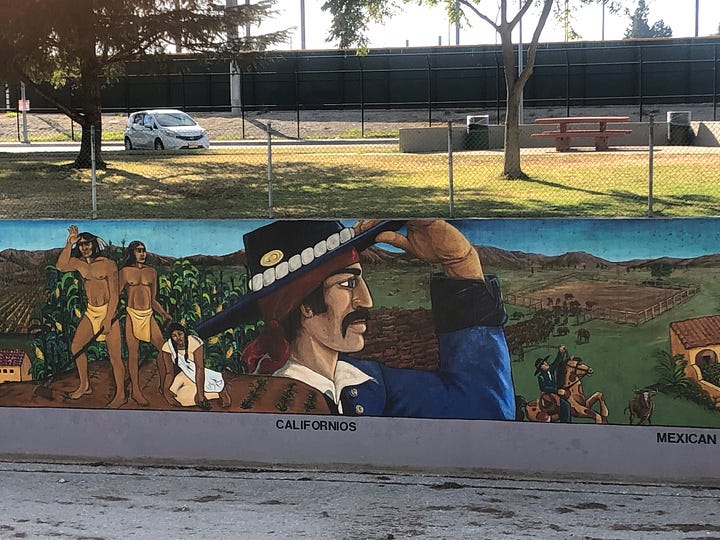

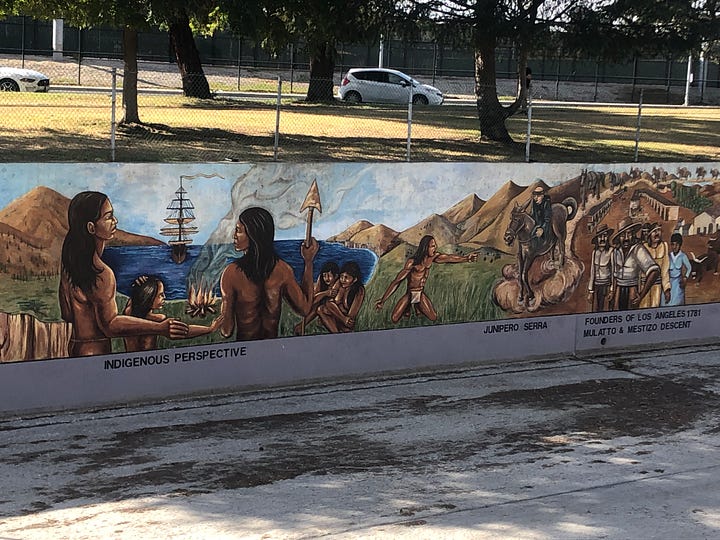
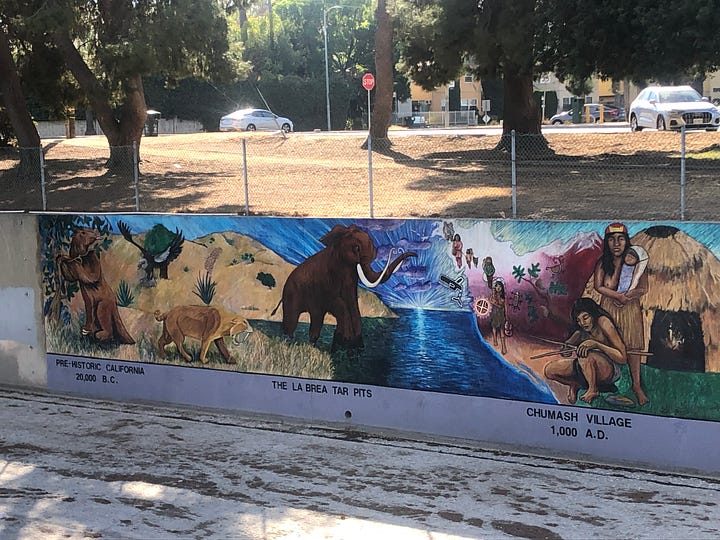
More and more however, public art seems be integrated into space’s alienation, the transformation of that space beyond the permission or even notification of those who inhabit it. Where art brings history and contingency together, its usage in the contemporary (gentrified, authoritarian) city forecloses these into something foregone.
How does the radical artist square this circle? Can it be done? My friends Tish and Adam Turl say no, at least in the context of America’s biggest cities. It’s one of the reasons they’ve relocated to Carbondale, Illinois – a city situated closer to the rust belt fringes of American urban life.
Lately, large portions of LA’s Great Wall are fenced off. It’s chainlink fence primarily. You can still see the wall clearly, but you can’t walk right up alongside it. A footbridge has been built allowing pedestrians to cut across and over the river. The bridge, smartly, isn’t particularly eye-catching. It makes for a more convenient route for some to get to campus and, potentially, will allow one a different vantage of the wall’s murals. There are also plans to expand the mural, particularly its chronicle of the 1960s, including the Watts Riots, the LA chapter of the Black Panthers, the Chicano high school walkouts. (The new segments were housed at the LA County Museum of Art while SPARC founder Judy Baca worked on them, up until this past summer.)
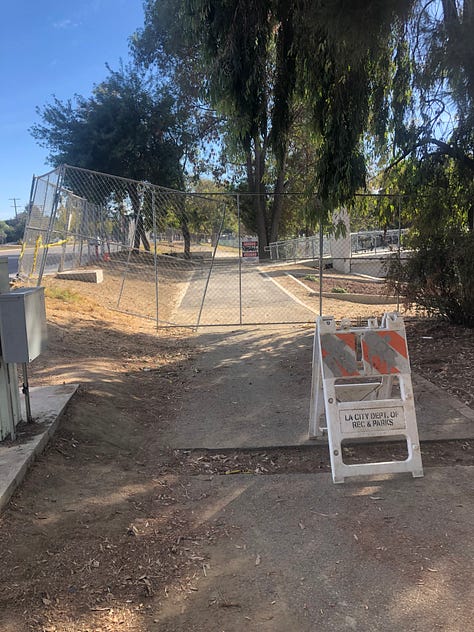


We’ve heard a lot about “liminal spaces” lately. They’re everywhere on TikTok and Instagram and the increasingly fractured world of the online. Liminal spaces are seemingly everywhere if you know where to look, promising the excitement of the strange, the unpredictable, the reinvented and reconceived.
It’s clear that the Great Wall, as it is originally conceived, deliberately plays with this liminality. A mural stringing together a people’s history of sorts painted on the wall of an aqueduct creates a sense of disruption, something smuggled in that nonetheless demands its place.
That a bridge is built over the wall is on its own harmless, even beneficial. Less so in the context of the general “revitalization” construction projects on the LAVC campus. Mind-numbing, mundane blocks that pretend to the stark angularity of brutalism but don’t have the bravery to really embrace it. The kind of buildings that flatten space and overwhelm the possibility of encounter with the nothing of empty time.
This is the problem. The more we notice liminal spaces, the more they are deliberately placed in the center of our already-taxed attention spans, the less liminal they become and, paradoxically, the easier it is to gloss over them. The apparent possibilities of place diminish. Its uses narrow.
This isn’t automatic. I am by no means deploying the hipster view of history, wherein the city is ruined by simple dint of trend or attention. Nor is the point here to say that the expansion of the Great Wall of Los Angeles, the artistic broadening of an Angeleno people’s history, is futile. Rather, it is to insist that public art is incapable of acting upon its viewers if those viewers are already passive. Artists forget this, often aiming for their art to “wake up” the audience, only to find that both art and audience have been rendered inert. That while they weren’t looking, history became something you pass briefly on the way to class.
It would be naive to think that the Trump presidency’s attacks on elite college campuses like Columbia and Georgetown won’t extend to less “elite” institutions. At the very least, the cuts in funding and criminalization of protest will have a knock-on effect for community colleges like LAVC. What could be a vibrant hub of a North Hollywood still clinging onto its polysemic histories runs the risk of becoming just another weight, anchoring this neighborhood and its people in static place. There is a very good chance that all of us are about to know what it looks like to live in the authoritarian city in the near-future. Whether artworks like the Great Wall of Los Angeles can play a role in driving some sort of wedge into it is an open question.




